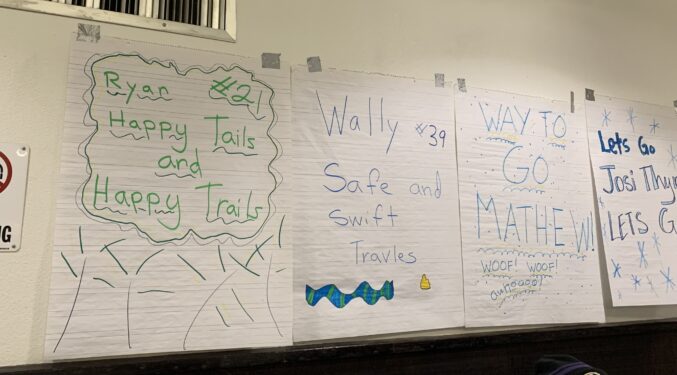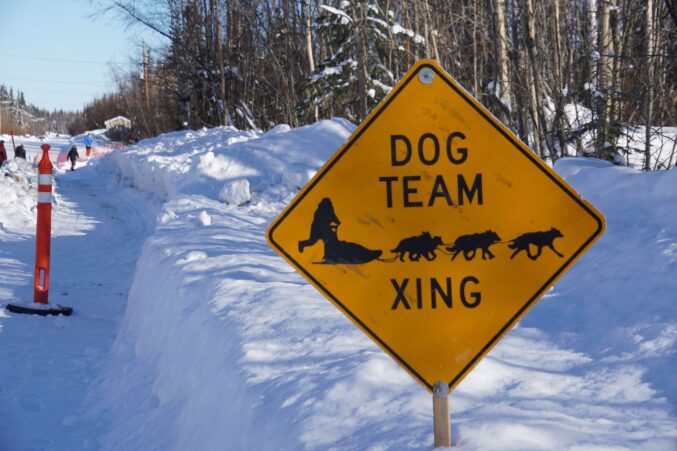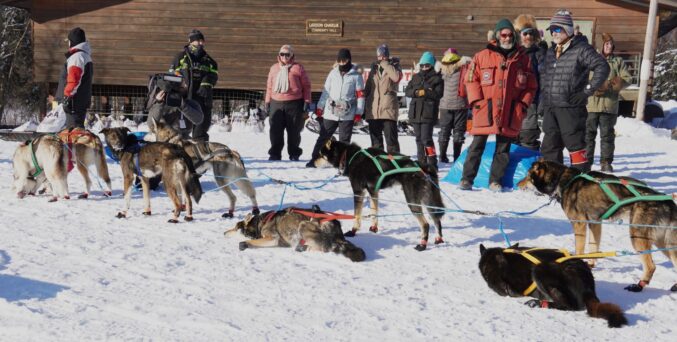I’ve been at Galena for about 27 hours now. In that time I’ve observed many interactions that help me understand better what community means. Here are some examples: Charlotte, who lives in this remote Alaskan village, brought moose soup for the mushers. Robert and Katie, volunteers, attend the comms desk and do a great job of giving out important information to the volunteers gathered here. When frontrunner Travis Beals and his team arrived, trail volunteers, vets, and camera crew gathered around to celebrate his arrival and provide straw, Heet, and the drop bags Beals sent out ahead of time.
Local students made signs for the mushers that hang in the community center. Small groups of volunteers are gathered around tables, sharing beading, knitting, card games, and puzzles while waiting for the next team to come in. Tables along the wall are full of food, much of it brought by the local people.

Galena students made posters for the community center. Photo: K. Newmyer
The Stanford Social Innovation Review (SSIR) has a great definition of community that I think students of all ages can easily understand: “Community is both a feeling and a set of relationships among people. People form and maintain communities to meet common needs.” The examples I mentioned above aren’t just individual acts, they embody the feeling of the Iditarod and the relationships that form when people come together to support the race. The residents of Galena make room for volunteers from outside to take over their community center for comms, trail crew, vets, mushers, and other volunteers, and of course, they are welcome to mingle also. The road in front of the center becomes a dog team crossing, and teams get to park on the frozen Antoski Lake. Everyone in Galena is here to form a community around the mushers competing in the Iditarod.

A sign lets the community know to watch for dog teams. Photo: K. Newmyer
The SSIR goes on to say, “Members of a community have a sense of trust, belonging, safety, and caring for each other. They have an individual and collective sense that they can, as part of that community, influence their environments and each other.” I love this statement because it closely connects with my morning excursion with Dr. Tammy Huntington who works at the Edgar Nollner Health Center in Galena. (Edgar Nollner was the last surviving member of the relay team that brought diphtheria serum to Nome in 1925.) She showed me the clinic and all of the schools that serve the town and surrounding area. We stopped by the hardware store, where Joe told me about how his store helps people in the community get building materials quickly and easily.
At each checkpoint, the community of people coming together to support the Iditarod transforms each local environment into a friendly and welcoming checkpoint for Iditarod mushers and their dogs, complete with all the amenities. Care is taken to return the environment to its original state when the checkpoint closes so that town members can have their spaces again.

Travis Beals’s team is greeted by volunteers and community members. Photo: K. Newmyer
I don’t think it’s too “pie in the sky” to imagine recreating the Galena checkpoint community in your school, and to invite families, friends, and local people to participate. Here’s how it could look.
Imagine an evening event centered around the Iditarod. Along with your school’s core values, have students create posters of the Eight Traits of the Iditarod: Innovation, Diligence, Integrity, Teamwork, Attitude, Respect, Optimism, and Determination. (Download the posters from Sanka W. Dog here.) Students and their guests can create signs that cheer on the mushers to decorate the room. Provide food or set up a potluck. Don’t forget Pilot Bread, your favorite chili, and Tang! Of course the best time to do this would be during the race. Have a “comms” table set up with the GPS tracker displayed. At other points around the room, show the live camera feed from current checkpoints.
In order to recreate the community atmosphere and help people learn about the Iditarod, set up tables where visitors can do the different Iditarod jobs. The vet table should have stethoscopes and teach people how to do the HAWL exam on a dog, checking from nose to tail. Plush husky dogs work great for this. You can have vet books for students to record information about their dogs. Another area should represent the check-in location and the checker’s clipboard. Have cones or barriers for the teams to enter the checkpoint and a basket or cart with mandatory gear. Set up a table where people can look at dog booties, posters, race guides from past years, and other memorabilia. Your Iditarod Insider crew—perhaps students who have become experts on the Iditarod—can share interviews and information. These students can interview guests at your event.
Since we are going with “pie in the sky” event planning, I encourage you to reenact or try to recreate the atmosphere of anticipation that is present in Galena checkpoint right now as I write. Matt Hall, currently in 2nd place, is due in a little while and people are waiting and discussing the incoming set of mushers—the front runners that include Hall, Dallas Seavey, Pete Kaiser and Jessie Holmes, with Travis Beals already resting in the checkpoint. Have your comms people share out the next musher coming in and include projected times; then have people welcome the musher in! Your trail crew can spring into action providing straw, fuel for dog food cookers, and the musher’s drop bags.

Drop bags and dog food cooker (hot water heater). Photo: K. Newmyer
After seeing how the Galena checkpoint community comes together to support the mushers, I have no doubt that people here will be transformed by the experience. I know I have been. Each checkpoint is unique but there is a common thread: a sense of community. The Iditarod is a great example of an event that creates bonds of trust, safety, and caring among like-minded people. School communities can strive to create the same community around the Iditarod, and every day.
Email me at emailtheteacher@iditarod.com if you have a community event you’d like to share.


